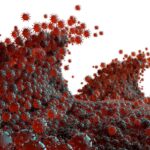How we know we're in a new wave and what we might be in for.
Australia is now into its next COVID wave. We’ve seen hints of this for a while. Case numbers and indicators of severe disease began rising in Victoria in August. But it has taken several months for a consistent pattern to emerge across Australia.
Now we see evidence of this new wave via wastewater surveillance for traces of SARS-CoV-2, the virus that causes COVID. We also see rises in COVID-related hospital admissions and antiviral prescriptions. Compared to past waves, this one has built up slowly and over a longer period.
Here’s what we know about this new wave and what to expect over the coming weeks.
How do we know we’re in a new COVID wave?
In earlier waves, when more people were testing for COVID and reporting their results, we were more confident case numbers were a reasonable reflection of how COVID was tracking.
However, now, a more useful indicator for COVID nationally is to look at trends in the number of prescriptions for the antiviral medications ritonavir (Paxlovid) and molnupiravir (Lagevrio) on the Pharmaceutical Benefits Scheme (PBS).
In the graph below, which is drawn from national prescribing data, you can clearly see script numbers rising.
When will we hit the peak?
It has become more difficult to predict the size and timing of the peak. Reduced access to COVID testing and fewer requirements or opportunities to report test results, combined with the slow growth rate for this wave, give a wider range of possibilities.
The wave is also likely to differ between states and territories, as some got off to a later start.
However, given the wave’s slow growth rate and further increases in hybrid immunity (immunity from both vaccination and infection) over 2023, it’s reasonable to expect this to be the smallest Omicron wave so far.
We also expect it will be over by early in the summer holiday period. That’s when rates of community contact decline significantly, as work and school contacts are much reduced. That means fewer opportunities for the virus to spread between networks of family and friends.
Why now?
It’s unlikely this latest COVID wave stems from changes in behaviour. People are generally out and about, fewer people are wearing masks in public. But we don’t see any dramatic shifts in this type of behaviour in 2023 compared with 2022.
It’s not a seasonal cause, given respiratory viruses tend to spread better in winter, when we’re cooped up indoors with others.
It’s unlikely it’s our waning immunity from infection or vaccination that’s prompting these successive waves.
Instead, we’re seeing the result of a constantly mutating virus. Successful SARS-CoV-2 variants are gradually acquiring mutations. Some of these changes reduce the ability of existing antibodies to bind to and neutralise the virus. So it appears it’s still the “immune escape” variants that are behind these latest waves.
Which variants are to blame?
The primary viral lineage in Australia this year has been XBB. Over the past six months, its two most influential mutations have been:
- the F456L mutation that led to the rise of EG.5.1, also known as Eris
- more recently, the paired “FLip” mutations F456L+L455F. We see these in offspring of Eris and in much-less closely related lineages. This is a clear sign these mutations help the virus spread better.
Both the single and paired mutations make existing antibodies less effective at blocking SARS-CoV-2 from binding to critical receptors on our cells. This increases our susceptibility to infection.
Email Twitter Facebook111 LinkedIn Print
Australia is now into its next COVID wave. We’ve seen hints of this for a while. Case numbers and indicators of severe disease began rising in Victoria in August. But it has taken several months for a consistent pattern to emerge across Australia.
Now we see evidence of this new wave via wastewater surveillance for traces of SARS-CoV-2, the virus that causes COVID. We also see rises in COVID-related hospital admissions and antiviral prescriptions. Compared to past waves, this one has built up slowly and over a longer period.
Here’s what we know about this new wave and what to expect over the coming weeks.
How do we know we’re in a new COVID wave?
In earlier waves, when more people were testing for COVID and reporting their results, we were more confident case numbers were a reasonable reflection of how COVID was tracking.
However, now, a more useful indicator for COVID nationally is to look at trends in the number of prescriptions for the antiviral medications ritonavir (Paxlovid) and molnupiravir (Lagevrio) on the Pharmaceutical Benefits Scheme (PBS).
In the graph below, which is drawn from national prescribing data, you can clearly see script numbers rising.
When will we hit the peak?
It has become more difficult to predict the size and timing of the peak. Reduced access to COVID testing and fewer requirements or opportunities to report test results, combined with the slow growth rate for this wave, give a wider range of possibilities.
The wave is also likely to differ between states and territories, as some got off to a later start.
However, given the wave’s slow growth rate and further increases in hybrid immunity (immunity from both vaccination and infection) over 2023, it’s reasonable to expect this to be the smallest Omicron wave so far.
We also expect it will be over by early in the summer holiday period. That’s when rates of community contact decline significantly, as work and school contacts are much reduced. That means fewer opportunities for the virus to spread between networks of family and friends.
Why now?
It’s unlikely this latest COVID wave stems from changes in behaviour. People are generally out and about, fewer people are wearing masks in public. But we don’t see any dramatic shifts in this type of behaviour in 2023 compared with 2022.
It’s not a seasonal cause, given respiratory viruses tend to spread better in winter, when we’re cooped up indoors with others.
It’s unlikely it’s our waning immunity from infection or vaccination that’s prompting these successive waves.
Instead, we’re seeing the result of a constantly mutating virus. Successful SARS-CoV-2 variants are gradually acquiring mutations. Some of these changes reduce the ability of existing antibodies to bind to and neutralise the virus. So it appears it’s still the “immune escape” variants that are behind these latest waves.
Which variants are to blame?
The primary viral lineage in Australia this year has been XBB. Over the past six months, its two most influential mutations have been:
- the F456L mutation that led to the rise of EG.5.1, also known as Eris
- more recently, the paired “FLip” mutations F456L+L455F. We see these in offspring of Eris and in much-less closely related lineages. This is a clear sign these mutations help the virus spread better.
Both the single and paired mutations make existing antibodies less effective at blocking SARS-CoV-2 from binding to critical receptors on our cells. This increases our susceptibility to infection.
The novel BA.2.86 lineage – colloquially known as Pirola – was first reported in Denmark in August and has many unique mutations. It has not been influential so far in this wave in Australia. But it has continued to evolve. And we may see it play a much bigger role in Australia in 2024.
Who is most at risk during this COVID wave?
Since the start of the pandemic, rates of COVID-related death and severe disease have greatly declined. That’s due to widespread vaccination and hybrid immunity, and a major change in the Omicron variant that’s made the virus less-likely to infect the lung.
However, provisional statistics show there have been about 3,000 registered COVID deaths in Australia from January to July 2023.
Older people and those with weaker immune systems are expected to remain at greatest risk of developing severe COVID during this current wave.
This is the rationale for the Australian Technical Advisory Group on Immunisation’s (ATAGI) September recommendation for people aged 75 or older to get boosted if more than six months had passed since their last vaccine dose.
ATAGI also recommended people aged 65-74, and people 18 years and over with severe immunocompromising conditions, consider having another booster.
But, by the end of October 2023, it was estimated only one-quarter of Australians aged 65-74, one-third of people aged 75 or over and fewer than half (45%) of people in aged care had received a COVID vaccine in the past six months.
Which vaccines are available?
Currently available bivalent vaccines protect against the original ancestral strain of SARS-CoV-2 (now extinct) plus the newer BA.1 or BA.4/5 variants. These bivalent vaccines also protect us against severe disease from the Omicron variants circulating now, such as XBB.
But we can expect newer monovalent XBB.1.5 vaccines soon, now the Therapeutic Goods Administration has approved them. These are expected to provide better protection against newer Omicron variants than the currently available bivalent vaccines.
In the meantime, boosting with any available COVID vaccine will provide good protection for vulnerable people.
What might we expect from COVID in 2024?
The Northern Hemisphere appears to have settled into an approximate seasonal pattern of COVID infections in 2023 and it’s plausible Australia will follow suit.
If so, we should plan for overlapping seasonal epidemics of our three most important respiratory viruses: SARS-CoV-2, influenza and respiratory syncytial virus (RSV). So hospitals may need to plan ahead for larger peaks in admissions.
Hopefully, new vaccines for RSV, and more broadly protective flu and COVID vaccines to be developed over the next decade, should help.
This article was originally published by The Conversation.
James Wood is a professor of epidemiological modelling of infectious diseases, UNSW Sydney. Bette Liu is an associate professor and NHMRC Career Development Fellow at UNSW Sydney. Katie Louise Flanagan is an infectious diseases specialist and clinical professor at the University of Tasmania. Stuart Turville is an associate professor for the Immunovirology and Pathogenesis Program at the Kirby Institute, UNSW Sydney.





